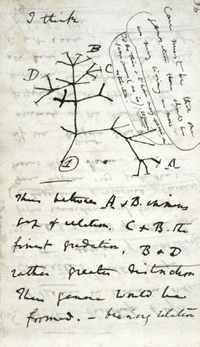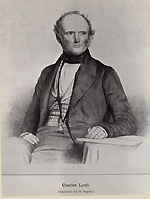Origins of the Origin
Darwin and the Beagle Voyage continued

Drawing of evolutionary tree of life, from Darwin’s Notebook B.
After arriving back to England, in 1836, Darwin quickly hit upon his theory of evolution. He threw himself into the work of distributing to specialists the specimens he had collected, writing up the scientific accounts of his explorations, and pondering what he had seen.

Charles Lyell (1797-1875), circa 1870
By the summer of 1837, the pieces began to fall into place: Darwin used the idea of the “tree of life” to consider that variations within species slowly diverged one from another until new and distinct species form. In fall 1838, he read An Essay on Population by Thomas Malthus (1766-1834)—and the disparity between resources and fruitfulness struck him forcefully. He extended Lyell’s method of understanding geological change to living matter. Instead of wind and water, the shaping force was the scarcity of resources; instead of volcanoes or earthquakes, the uplifting force was the fecundity of nature. Between the two, living matter was sculpted no less than cliffs and valleys. Darwin saw “a force like a hundred thousand wedges [pushing] every kind of adapted structure into the gaps of the oeconomy of nature . . . ,” as he recorded in his notebook. [Darwin, Notebook D, Transmutation of Species, July through October 1838, p. 135e, 28 September 1838] He could posit “the origination of fresh species” by using the forces that nature herself supplied.
Last Reviewed: January 25, 2024


